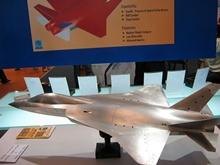India, Russia to move ahead with 5th generation fighter jet deal
08 May 2017
India and Russia have finalised the terms of engagement for the joint development of the proposed fifth generation fighter aircraft (FGFA) and are likely to soon enter into a "milestone" agreement on the design details of the aircraft and move ahead with the multi-billion dollar co-development project.
 Government sources said almost all the ground work has been completed to finalise the deal for design of the jet as well as some other critical issues.
Government sources said almost all the ground work has been completed to finalise the deal for design of the jet as well as some other critical issues.
"The contract for the detailed design would be signed soon and that will be a major milestone. It should be signed in the second half of the year," reports quoting a top official involved in the negotiations with Russia on the project said.
India had insisted on full transfer of technologies to the Indian partner or other designated Indian entities in order to participate in the joint development of the FGFA, defence ministry sources in New Delhi had earlier said.
The issue has now been resolved as there is no need for technology transfer clause in the agreement since the technology will now be jointly developed by two countries.
India had insisted on technology transfer to avoid "mistakes" made during the earlier acquisition of Russia's Sukhoi Su-30MKI jets, which had not mentioned the transfer of technology aspects.
The FGFA project, to be jointly developed by Russia Sukhoi aircraft manufacturer and India's Hindustan Aeronautics Ltd, is part of the `Make in India' initiative launched by Prime Minister Narendra Modi in 2014.
The two countries, incidentally, had inked the FGFA inter-governmental agreement way back in 2007, which was followed by a $295 million preliminary design contract in 2010 before the negotiations got stalled.
The FGFA project failed to take off due mainly to problems with the earlier agreement pointed out by the Indian Air Force.
IAF has been unhappy with Sukhoi because the jet lacks proper stealth. Also, defence ministry sources say this decision has been taken at the "highest levels" in order "not to repeat the mistakes" of the entire Sukhoi-30MKI jet acquisition programme.
The Sukhoi project cost India Rs55,717 crore, but it did not give the country any tangible benefit in developing indigenous fighter-manufacturing capabilities.
"Though bulk of the 272 Sukhois (240 inducted till now) contracted from Russia have been made by Hindustan Aeronautics (HAL), they have been basically assembled here with imported knocked-down kits. HAL still cannot manufacture the Sukhois on its own," the report quoted the official as saying.
A HAL-made Sukhoi costs around Rs450 crore, about Rs100 crore more than the price of the same jet imported from Russia.
India now wants value for money for the estimated $25 billion it will spend to induct 127 of these single-seat jets.
In March, India and Russia had signed two key agreements for long-term maintenance and technical support for Russian- made Su-30MKI fighter jets of the Indian Air Force.
Currently, the IAF operates around 230 Su-30MKI fighter jets and, as per the agreements, Russian defence majors United Aircraft Corporation and the United Engine Corporation will render technical support and provide maintenance services and spares for the fleet for a period of five years.
The joint development of the FGFA would help the indigenous FGFA project called the advanced medium combat aircraft (AMCA), the preliminary design work for which is now under way.
IAF has been unhappy with the Russian FGFA called Sukhoi T-50 or PAK-FA because the jet lacks proper stealth and its engine does not have "enough thrust", which are among 43 critical modifications or shortcomings it pointed out earlier.
Russia, however, is reported to be promising that the Indian FGFA or the "perspective multi-role fighter" will be quite different from the Sukhoi T-50, with more powerful engines and other capabilities. As per the R&D contract, India and Russia are to contribute $4 billion each for prototype development, testing and infrastructure build-up.
Final production and deliveries of the fighters, which would involve fresh production contract, were earlier expected to begin 94 months after signing of the contract.













.jpg)






.jpg)









